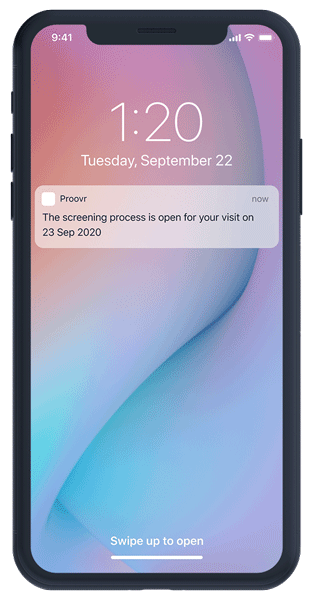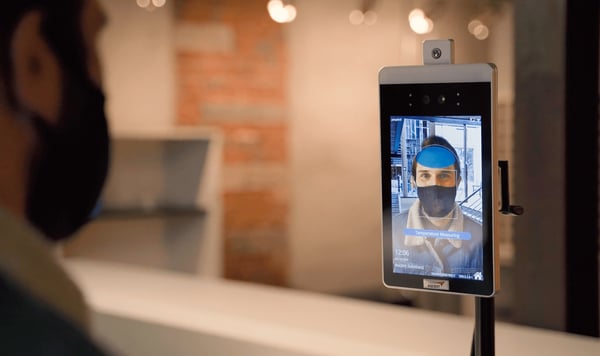As vaccine numbers rise and major cities make plans to reopen their economies, it seems that there is finally a light at the end of the proverbial tunnel.
However, the impact of the COVID-19 pandemic on the commercial real estate (CRE) industry has been significant, both in terms of economic ramifications and vast changes in daily operations to workspaces around the globe.
As a result, the commercial property management industry has been forced to adapt quickly.
Some of these changes are temporary, and will eventually revert back to “business as usual” - but others are permanent, and represent a trend of owners, clients, investors, and other stakeholders re-evaluating their strategies for everything from visitor management to office space allocation, to space utilization and optimization as a whole.
Key takeaways from our 2021 CRE survey
Proxyclick partnered with CREtech and global research firm OnePoll to conduct a survey of over 300 commercial real estate professionals, the majority of whom were higher-level property managers or other corporate decision-makers across an array of CRE areas.
The goal of the survey was to assess their experiences not only in the CRE market currently, but also to gain insight into their projections for the future of CRE, including the biggest demands and trends that will define the market after the global health crisis is behind us.
Here are some of the most significant takeaways from the survey, concerning the future of commercial real estate and, importantly, the technologies that power it.
To learn more, read the free, full version of the 2021 CRE Tech Report below.
Occupancy has declined, but not for long
Perhaps the most salient of the pandemic’s effects on work-life has been the near-universal shift, across all industries, to work-from-home or other remote work arrangements. In the commercial real estate space, it comes as no surprise that this change has presented particular challenges.
However, at the time of the survey, nearly three-quarters of respondents indicated that their commercial spaces had regained some occupancy, and over a third expect that “everyone will be back” in their usual offices within 12-18 months' time.
At the same time, over a third of respondents also believe that flexible workspaces are here to stay, and will even increase in popularity. Co-working and other flex spaces, including shared desks, offices, conference rooms, and other workspaces, are widely considered to promise significant growth in the next few years.
"A lot of landlords also see flex space as an opportunity to retain their tenants. They (tenants) get access not only to many floors in their building, but also to beautiful flexible spaces with food and beverage offerings and a lounge." - Tashi Dorjee, Head of Flex Space, Australia & New Zealand, JLL
To manage hybrid work environments that rely on the ability to co-work, integrated systems for space and room reservations will likely become a staple of successful CRE enterprises, even after the pandemic is in hand.
A continued focus on wellness and safety
Despite the broad expectation that everyone will be back in the office in the not-too-distant future, there remains a significant concern among CRE professionals about a crucial issue: How to keep everyone healthy.
“Broadly speaking, the office - whether it's a desk at a co-working space or that empty seat waiting for you back at the headquarters - has to earn back the consumer's trust. There has to be a reason that you'd want to go back to it.” - Mark Gilbreath, CEO & Co-Founder, LiquidSpace
Granted, the expedited distribution of vaccines will certainly help - but as the pandemic becomes more of an endemic situation, it remains important for CRE professionals (as well as company HR folks) to make sure solutions are enabled that keep visitors, contractors, vendors, and day-to-day employees safe. And only a little over half of those surveyed feel adequately prepared to do so.
Some of the most popular solutions include pre-registration emails sent to everyone who is planning on coming to the company premises, regardless of status with the company.

These electronic invitations can include not only vital meeting information, but health and wellness questionnaires designed to ask the recipients about any illness symptoms they may be experiencing.
Assuming entrants report no symptoms, the CRE professionals we spoke to reported that they are increasingly relying on tools such as:
- infrared temperature scanners at entry,
- touchless check-in facilitated with unique QR codes (sent to recipients’ smartphones in advance),
- digital access to doors, turnstiles, and elevators (via the same QR codes),
- remote registration for desk or room occupancy, and,
- monitored people flows to make sure that safe social distancing is maintained on the premises.
Unified tech processes are the key to success
The vast majority of respondents to our survey believe that technology will be the key to a safe return to work - and nearly all of those surveyed share the view that unified processes are essential to that goal.
"Companies that didn't have the tools or the data necessary to be able to go through these transformations are going to need to not only get the tech in place to manage COVID-19 and their return to the office, but also to be able to rationalize their space." - Lorri Rowlandson, Senior Vice President of Strategy and Innovation at BGIS
Rather than relying on multiple new software systems, particularly ones that don’t integrate well with legacy hardware, CRE professionals are looking for solutions that “do it all” - that integrate with existing system architecture, without having to go through costly and painful technology overhauls, and still provide robust safety and security tools.
Property managers and HR professionals are thus prioritizing systems that can deliver all the safety features they are looking for, and combine data from multiple sources.
In addition to the solutions such as infrared temperature checks and touchless check-in, described above, CRE professionals are prioritizing features such as occupancy/tenant management systems, meeting room reservation systems, capacity/occupancy management, emergency communication tools, and overall tenant experience, ideally, all rolled into the same platform.

The goal is to provide C-suite types, HR personnel, and security professionals with real-time data about who is on the premises when, ensure that everyone is situated safely, and communicate quickly and efficiently with all occupants in the event of an emergency.
A final note on emerging CRE trends
One of the silver linings of the global health crisis has been the accelerated development of integrated systems that can “do it all” - not only managing visitors, but also contractors, vendors, and day-to-day employees - in ways that unify safety regulations, access requirements, and existing technological architecture that companies already use and are satisfied to keep using.
These systems, such as Proxyclick, have all the tools CRE professionals need (people flow management, attendance schedulers, space management, access control, universal health screening capability) while also providing another perk: a welcoming, efficient, streamlined entry experience for visitors and regulars alike.
The new generation of integrated solutions not only provides necessary safety features, but also facilitates building security and data privacy, and creates a great first impression for the company.
If you'd like to learn more about how CRE technologies are permanently changing the workplace for the better, we invite you to check out the results of our 2021 CRE Tech Survey.
